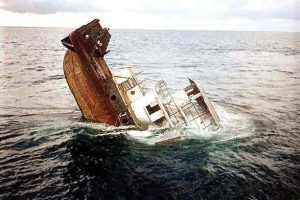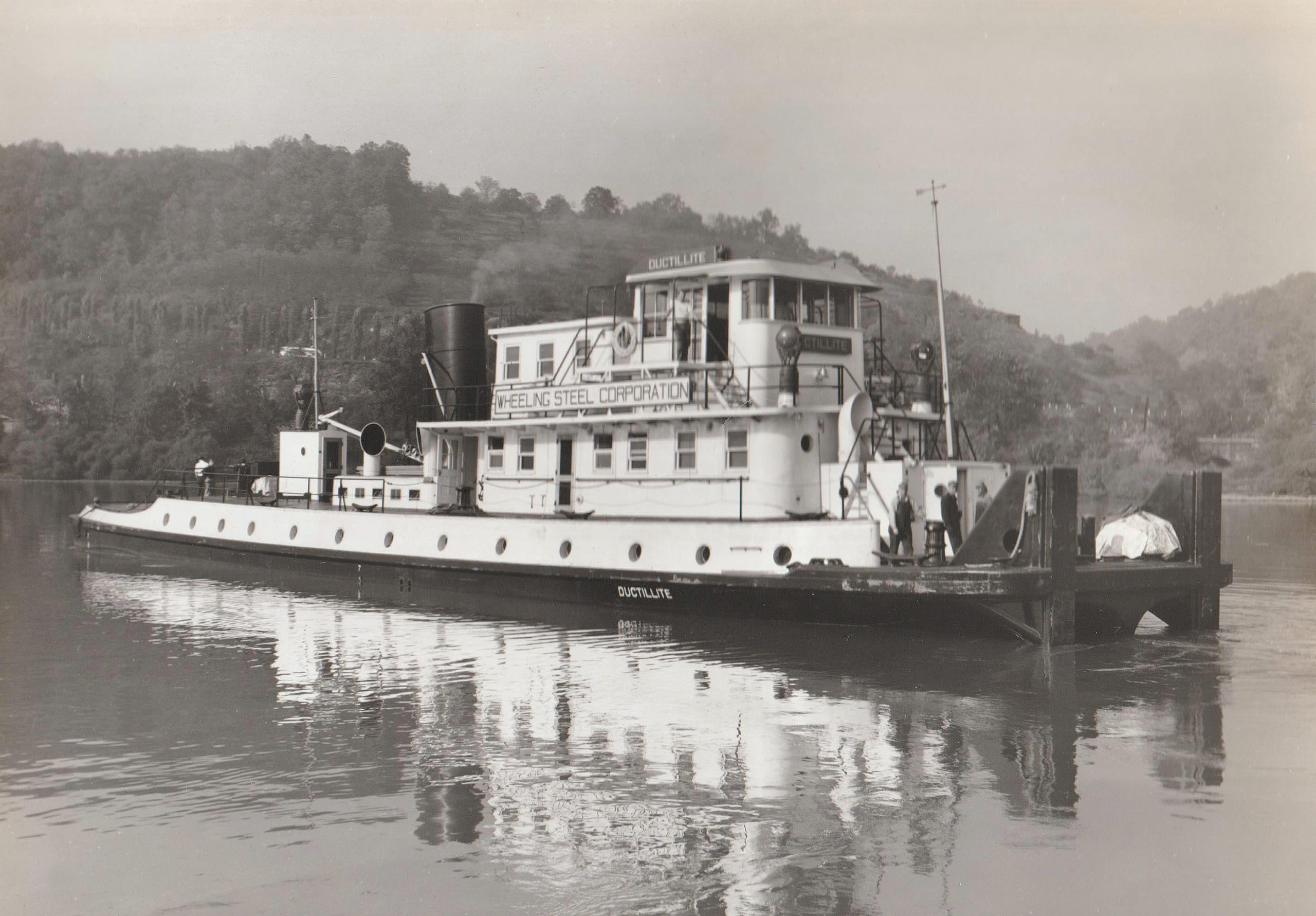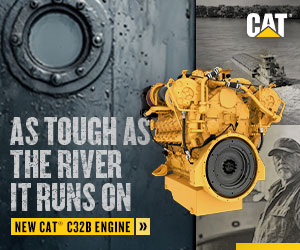In late 1939, a brief announcement was made in The Waterways Journal and other publications that Dravo Contracting Company was working on designs for a towboat that would be much different from any seen on the river system. The vessels would be of twin screw propulsion and utilize the kort nozzles that had been designed in Germany and that Dravo had exclusive rights to in the United States. The nozzle had been tested in 1937 on the small single screw Pioneer, built by Dravo in 1934. A near duplicate to the Pioneer, the Dravo 42, was built with the nozzle in 1938, and it performed well. An odd feature of the proposed new design was that it had some quarters located below the waterline.
A series of three of these new vessels was planned. The first of this design to come down the Dravo ways at Neville Island, Pa., would be the Ductillite for Wheeling Steel Corporation. The Ductillite was launched on July 25, 1940, and followed the large Wm. Penn that had launched on June 19 and was detailed in this column in the issues of July 8 and July 22, 2024. While smaller than the Penn at 135 by 27, the Ductillite shared similar shapely hull lines. It was powered by a pair of Cooper-Bessemer JS-6 direct reversing diesels, which produced 760 hp. at 310 rpm. It was estimated that the kort nozzles increased the horsepower to 950.
The unusual design of the new boat was most evident in the row of portholes seen just above the waterline along the area between the very bow and stern of the craft. The quarters for the deck crew were found in the lower area just forward of the machinery spaces, and the galley and dining room were in the lower area immediately aft of the engine room. The portholes provided light and ventilation for all of those areas.
From the bow or stern it was necessary to go up a few steps to access the main deck area where there was a cabin containing more crew quarters on the forward end, an engine room skylight atop which was a tall single smoke stack and four ventilators and, at the after end, a covered stairway for access to the galley. An elevated pilothouse was above the forward end of the main cabin with a small cabin aft of that with rooms for the captain and pilot.
Trials for the Ductillite took place in late September 1940, shoving and backing on a loaded tow with the Dravo dynamometer barge between the boat and tow. Photos of the launching of the Semet-Solvay on September 21, 1940, the third boat in the series, show the Ductillite retrieving the new boat as it comes off the ways. Another photo taken at the Dravo outfitting dock on October 10, 1940, shows the completed Ductillite still there, nosed in alongside the sister vessels Semet-Solvay and Victory.
At some point soon after this, the new diesel Ductillite joined the fleet of Wheeling Steel Corporation, Wheeling, W.Va. It joined the steam sternwheelers Carbon (Ways T0503), LaBelle (T1536) and the small Cop-R-Loy (T0503) that shifted at the Wheeling mill at New Boston, Ohio. The firm also had a small diesel sternwheel boat named D.A.B. at this time. The new diesel prop boat would have certainly raised eyebrows with its radical new looks, but it was certainly a great performer.

The mv. Deborah, sunk to form an artificial reef, June 24, 1999. (From the author’s collection)
Wheeling Steel phased out the steamboats in their fleet, adding the 1,000 hp. diesel La Belle, built by Hillman in 1947. In 1958, the company had the 2,400 hp. Robert E. Reed, built by St. Louis Ship, and the following year the Ductillite was sold to the R.W. Greene Sand & Gravel Co., Louisville, Ky., and renamed Jennie A. Greene. The vessel was in that company’s service until it sold in August 1968 to White Bros. Inc., Belle, W.Va.
The boat was renamed Juanita White in honor of the wife of Capt. Harry F. White. Soon after purchase, it was repowered with a pair of Cat D 397 engines that had been removed from the dismantled sternwheel Chickasaw (WJ November 27, 2023). These engines, coupled with Twin Disc 3.862:1 gears, gave the White 900 hp. Painted a bright white with “Kanawha River red” decks and a green visor on front of the pilothouse, the boat became a familiar sight on the Upper Ohio and Kanawha Rivers with the radio call sign WF 5028.
The Juanita White was often found on charter to Crounse Corporation, towing coal from the Kanawha to the J.M. Stuart power plant at Aberdeen, Ohio. Capts. Dizzy Lee, Jake Burge and Landis Pearson were fixtures aboard for many years. George Crounse Jr. formed St. James Transportation Co., Madisonville, La., and purchased the Juanita White in January 1980. It then explored rivers of the deep south, including the Gulf Intracoastal Waterway.
In 1982, it was repowered with a pair of Cat 3508 engines coupled to Twin Disc 5.17:1 gears, and was then rated at 1,410 hp. The following year, it was renamed Crescent, and under this name visited Point Pleasant, W.Va., at the mouth of the Kanawha at least one more time. In 1989, it was renamed Deborah. In 1992, it was sold to Brown Marine Service, Pensacola, Fla., which dismantled it. On June 24, 1999, this once proud and radically designed boat was sunk to form an artificial reef off Okaloosa County, Fla.




